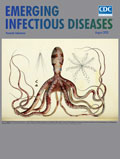
Volume 26, Number 8—August 2020
Research
Human Outbreak of Trichinellosis Caused by Trichinella papuae Nematodes, Central Kampong Thom Province, Cambodia
Yannick Caron , Sotharith Bory, Michel Pluot, Mary Nheb, Sarin Chan, Sang Houn Prum, Sun Bun Hong Lim, Mala Sim, Yi Sengdoeurn, Ly Sovann, Virak Khieu, Isabelle Vallée, and Hélène Yera
, Sotharith Bory, Michel Pluot, Mary Nheb, Sarin Chan, Sang Houn Prum, Sun Bun Hong Lim, Mala Sim, Yi Sengdoeurn, Ly Sovann, Virak Khieu, Isabelle Vallée, and Hélène Yera
Abstract
In September 2017, a severe trichinellosis outbreak occurred in Cambodia after persons consumed raw wild pig meat; 33 persons were infected and 8 died. We collected and analyzed the medical records for 25 patients. Clinical signs and symptoms included myalgia, facial or peripheral edema, asthenia, and fever. We observed increased levels of creatine phosphokinase and aspartate aminotransferase, as well as eosinophilia. Histopathologic examination of muscle biopsy specimens showed nonencapsulated Trichinella larvae. A Trichinella excretory/secretory antigen ELISA identified Trichinella IgM and IgG. Biopsy samples were digested and larvae were isolated and counted. PCR for the 5S rDNA intergenic spacer region and a multiplex PCR, followed by sequencing identified the parasite as Trichinella papuae. This species was identified in Papua New Guinea during 1999 and in several outbreaks in humans in Thailand. Thus, we identified T. papuae nematodes in humans in Cambodia.
Trichinellosis is a parasitic disease caused by nematodes of the genus Trichinella and acquired by ingestion of raw or undercooked meat from infected animals (nonuminant mammals, birds, and reptiles). Approximately 11 million persons worldwide might be infected by Trichinella spp. (1). Numerous animals species (≈100), including humans, can be infected and the most common source of human trichinellosis is meat from pig or wild pig (Sus scrofa) (2). Therefore, this zoonotic disease is not only a public health hazard but also represents an economic problem in porcine animal production and food safety. Some countries in Europe implemented a Trichinella monitoring program (3,4), and a Trichinella-free pig production pilot program has also been set up in the United States (5). Nevertheless, estimation of the effect of trichinellosis in developing countries with reference to public health and social and economic costs is difficult.
Recent studies on the genetic diversity, zoogeographic, and epidemiologic features within this genus resulted in a revised Trichinella taxonomy comprising 10 species (13 genotypes): encapsulated (T. spiralis, T. nativa, T. britovi, T. murrelli, T. nelsoni, T. patagoniensis, and T. chanchalensis) and nonencapsulated (T. pseudospiralis, T. papuae, and T. zimbabwensis) (2,6,7). In Southeast Asia, relatively few human outbreaks were recorded, but it has been calculated that >40 million persons are at risk for Trichinella infection in China (8). The presence of Trichinella antibodies in asymptomatic persons in a rural population of Cambodia (unknown location) was described (9), and another study reported 24 cases of Trichinella spp. in Khmer immigrants living in the United States (10). In Vietnam (11) and Laos (12), several outbreaks were reported involving T. spiralis nematodes. However, in Thailand, several human outbreaks involving T. spiralis, T. pseudospiralis, and T. papuae nematodes were reported (13,14).
The T. papuae nematode (genotype T10) is one of the most recently discovered species and was first detected in sylvatic swine of Papua New Guinea in 1999 by using molecular tools (15). In addition to being a nonencapsulated species, T. papuae nematodes are known to use mammals and reptiles (mainly crocodiles but also to a lesser extent caimans, turtles, and lizards) as hosts (16). Humans acquired the parasite by the consumption of raw meat from domestic animals, wild pigs, saltwater crocodiles, and turtles (17). This species was identified in Thailand in humans during outbreaks in 2006 (14) and 2007 (13) and in a patient returning from Malaysia in 2011 (18). The objective of this study was to report and describe a documented human outbreak of trichinellosis caused by T. papuae nematodes in Cambodia.






















.png)











No hay comentarios:
Publicar un comentario